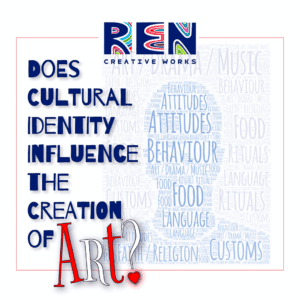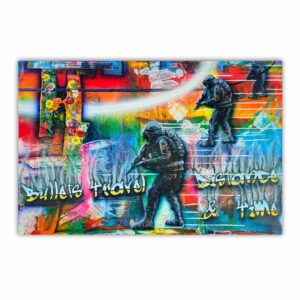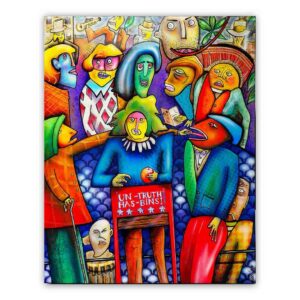- [email protected]
- +353 (0)86 224 0139
- Free Shipping Worldwide
The Influence of Cultural Identity on the Creation of Art
Art impacts society by developing opinions and influences culture in an assortment of ways. In this pillar post we explore, Does Cultural Identity Influence the Creation of Art?
Reading Time: 20 minutes
TL:DR
- Discover the hidden stories behind culturally influenced art, unravelling the rich tapestry of traditions, beliefs, and experiences that shape our artistic creations.
- Explore how cultural identity in art challenges stereotypes, breaks barriers, and opens up new dimensions of understanding, fostering a more inclusive and interconnected world.
- Be inspired to support and engage with art that embodies cultural identity as we celebrate the beauty of diversity and consider commissioning a unique piece that resonates with your own personal story.
Art: A Reflection of Culture’s Vibrant Tapestry
Art is a mirror reflecting the vibrant tapestry of cultures around the world. From the intricate patterns of a Navajo rug to the powerful murals of Mexico City, cultural identity leaves an undeniable mark on artistic expression.
This influence isn’t a one-way street. Cultural identity and art have a powerful interplay. Traditions, beliefs, and experiences of a culture shape the artist’s vision. In turn, art forms like paintings, music, and dance can preserve cultural heritage and even influence future generations’ identities.
Our sense of belonging is a combination of how we see ourselves and the culture that surrounds us. This cultural identity becomes a wellspring of inspiration for artists. A sculptor might honour ancestral deities through their work, or a musician might compose a song that reflects their homeland.
Art not only reflects cultural identity but also shapes it. Traditional art forms passed down through generations can serve as a powerful reminder of cultural heritage. This artistic legacy can influence how future generations understand their place within their cultural identity.
How Does Culture Affect Your Identity?
Cultural identity is the sense of belonging to a particular group of people who share similar traditions, values, and experiences define cultural identity. Cultural identity has a significant impact on the intercultural communication process.
As a result, it presupposes a set of consistent qualities that cause certain cultural phenomena or people to elicit feelings of sympathy or antipathy in us. We choose the appropriate type, manner, and form of communication with them based on this.
Finding Your Cultural Identity
So, how would you go about discovering or rediscovering your cultural identity? Perhaps you could try new foods and travel to your parents’ home country, if it differs from the country in which you now reside.
Learn something new or bring back a cultural ritual to share with family and friends. You might even discover that this gives you a new perspective on life and a new sense of identity.
Cultural Identity Psychology
In a modern society where the process of globalisation is deepening, constant contact between people from different cultural backgrounds will prompt reflection on cultural identity. Personal and national identity are built on cultural identity.
It has recently emerged as an important interdisciplinary field and one of the topics of interest to psychologists. Cultural identity research in psychology focuses primarily on developmental psychology, social psychology, and cross-cultural psychology.
According to developmental psychology, the construction and formation of individual cultural identity is a complex process of change. The relationship between cultural identity and self-esteem is the focus of social identity theory. Individual self-esteem will rise as a result of a strong and secure national identity.
Importance of Maintaining Cultural Identity
Cultural identity preservation is critical in order to maintain a sense of oneness and belonging among members of a particular cultural group. Poetry, traditions, dance forms, songs, rituals, and language are all examples of cultural heritage that forefathers passed down to the current generation.
It sometimes feels as if its very survival is jeopardised as a result of today’s hectic lifestyles and overwhelming social obligations.
The preservation of cultural heritage is founded on the protection of cultural identity. Cultural heritage is a right that must be safeguarded by the laws of the land.
Only through the preservation of our various heritages will future generations be able to understand and live according to the standards perceived by our ancestors.
"When one has weighed the sun in the balance, and measured the steps of the moon, and mapped out the seven heavens, there still remains oneself. Who can calculate the orbit of his own soul?”
Oscar Wilde - De Profundis: The Ballad of Reading Gaol and Other Writings (1905)
How Does Culture Influence Art?
We hear the words ‘culture’ and ‘art’ all the time, but we do not always understand what they mean or how deeply they have meaning. How are they related and how does art affect our culture?
Culture has been studied by philosophers, political scientists, educators, and others. The ancient Greeks associated culture with good breeding, education, and a love of the land.
- Physical culture is a subset of general culture that aims to improve a person’s physical skills. Physical culture emerged during the early stages of society’s development and continues to evolve to this day. Physical education now denotes not only concern for one’s health, but also one’s status as a social being. This culture is used in pedagogy as well as in family life, work, and education.
- Spiritual culture is a body of knowledge about religion, communication, creativity, and morality. Spiritual culture is formed as a result of a person’s ideas about the world around them and themselves as a part of that world.
- Artistic culture is a collection of aesthetic artistic values. Art, as the embodiment of artistic culture, has an impact on a person’s feelings and emotions. Not only must the best elements of ancient art be preserved, but new ideas must also be introduced into the modern understanding of art.
- Popular culture, as a subset of folk culture, is formed by the tastes of many people in a given society. It represents various forms of entertainment, including music, television, the internet, and sports. Art movements can influence society by forming opinions, instilling values, and unravelling experiences in the real world. Painting, music, composing, and various articulations are frequently regarded as a repository for an entire population’s total memory.
Teaching Culture through Art
Hands-on art experiences are an excellent way to teach culture, whether its differences or similarities. Many arts and crafts projects can engage all five senses and appeal to people of all ages.
The combination of sensory learning and cognitive development are some of the many benefits is especially for children. I am sure many readers have tangible items from school that they remember to this day!
“If you talk to a man in a language he understands, that goes to his head. If you talk to him in his language, that goes to his heart."
Nelson Mandela
Identity in Art Meaning
In the realm of art, identity holds a profound and multifaceted meaning. It serves as a cornerstone for artistic expression, reflecting personal narratives, cultural heritage, and societal influences. Artists often imbue their work with elements that speak to their own identities, whether it be through exploring themes of race, gender, or personal experiences.
The concept of identity in art is not static but rather dynamic and evolving. It can be a tool for artists to challenge norms, provoke thought, and spark conversations. By delving into the depths of their own identities, artists can create works that resonate with audiences on a deeply emotional level.
Art that delves into the complexities of identity has the power to evoke strong emotions and foster connections between individuals from diverse backgrounds. It prompts viewers to question their own perceptions and biases while opening up avenues for dialogue and understanding.
Ultimately, the exploration of identity in art serves as a powerful catalyst for introspection and empathy, bridging gaps between different perspectives and enriching our collective cultural landscape.
How Does Culture Influence Art?
Art is a vital component of society. History clearly demonstrates that art is more than what the senses recognise, but it is also a reflection of how colourful culture is. Various cultures have shaped and influenced art, causing it to look the way it does today.
The Greeks are undoubtedly one such example. They were the ones who came up with a clear definition of what art is all about. Greek art is known to have five distinct forms. Painting, jewellery making, sculpture, architecture, and pottery are examples of these forms.
The Greeks
Greek panel painting is widely regarded as one of the most prestigious art form. Panel paintings are mobile paintings that are created by hand on wooden boards. Encaustic painting and tempera were among the techniques used in this form of art. Portraits and still lives are common subjects for these paintings. Wall painting is another type of painting that has gained popularity among Greeks.
This art has a long history dating back to the Minoan and Mycenean eras. The “Tomb of Persephone” in Vergina, Macedonia, and the “Grace of Phillip” are two well-known examples of wall paintings. Polychromy, or the use of multiple colours, was also a result of the Greeks’ imaginative thinking. It has been used to improve the visual appeal of Greek edifices and sculptures.
Artists Who Explore Identity
- Alja Horvat The work of this young Slovenian artist is inspired by the culture of the 60s, 70s, and 80s. Horvat prefers to create illustrations on a graphic tablet but also likes to use gouache and acrylic paints. The peculiarity of her work is the skilful combination of pastel shades, as well as the image of greenery, the moon, stars, or the sun in all her works.
- Brunna Mancusa has extensive experience in the creative field and currently works with publishers and advertising agencies. At the same time, Brunna sees in her work a large space for experimentation in art with the help of other tools such as ceramics, embroidery, and engraving. The watercolour illustrations brought fame to the artist – they can be described as bold, modern, and feminine.
- George Grosz was a German artist known mostly for his caricatured drawings and paintings of Berlin life in the 1920s. Grosz was fiercely anti-Nazi, and his work is a very powerful visual record of German society of the time. He moved to America during the war, becoming a naturalized citizen of the U.S. in 1938, and returned to Berlin in 1959.
- Banksy: I would be extremely surprised if you have not heard of this artist before. Banksy’s work manages to brilliantly pass commentary on a variety of subjects, both by being influenced by culture and influencing culture itself. I recommend checking out both Dismaland and The Walled Off Hotel, or by going directly to Banksy’s website.
How Does Culture Affect an Artist’s Work?
This is an excellent question. Rather than comparing different artists under different cultural growth, the growth environment and political environment are compared vertically to the artist’s personal artistic career.
The aesthetics and preferences of the artist’s creation will, of course, be influenced by the growth environment, as will the artist’s entire artistic career and even his life. It means that an artist’s work is influenced by culture.
To some extent, all artworks are products of their culture, reflecting prevailing assumptions and beliefs. The greatest works of art, on the other hand, have the ability to transcend their time of creation.
Expressing Cultural Identity Through Art
Artists may use self-portraits or work that is symbolic of ancestry or culture to explore or portray their identity. This could be an attempt to see how they fit into contemporary culture. In order for artists to understand their environment and the world around them, they must first investigate themselves.
Expressing Tradition Through Art
Many artists have used art to explore questions of identity throughout the centuries. Despite the fact that our ethnicity or sexuality shape who we are, identity is fluid rather than fixed.
Our personal experiences, as well as the socio-political realities of our time, can alter our perceptions of ourselves and others.
We constantly reconsider our place in the world, as individuals and as members of communities, no matter where we live. This is especially true for those of us who are immigrants.
How Art Can Be Used to Challenge or Subvert Cultural Identity
Cultural identity is an important part of a person’s self-concept and can influence their behaviour. Theoretically, we know that cultural identity gives people a sense of belonging and self-esteem; having a strong cultural identity can lead to positive outcomes like self-esteem, happiness, and a sense of purpose.
However, identity politics can be abused by those in power through a cult of personality, as seen in the Nazi invasion of Poland.
Throughout the war, Poles used culturally coded signs and symbols to defy Nazi authority and rally support for the armed resistance movement.
Furthermore, posters, shrines, and statues, were used as visual symbols of Polish cultural identity and Catholicism during the Nazi occupation.
There has been a surge of creative expression that contradicts the dominant societal narrative over the last decade.
There have been a number of movements that have been especially influential in the Western world. From the art of the #MeToo movement, to Chinese contemporary artist, documentarian, and activist Ai Weiwei, these are examples of art that has impacted society and changed people’s perspectives.
Many artists hope that their work will raise people’s awareness of the nonsense they are fed on a daily basis, that are a challenge to, or subvert cultural identity.
What is my Cultural Identity?
I am sure the theme of “split identity” will strike a chord with many of you. I have strong ties to two countries that share a long and complicated history. The lyrics to “Irish Blood, English Heart” by Morrissey, is a good starting point.
Over time identity develops, I identify as a European with a naive interest in internationalism.
I believe that humans should work together to advance their common interests across national, political, cultural, racial, and class lines.
Governments should work together because, in my opinion, mutual long-term interests are more important than short-term disagreements.

Conclusion: Culture is Art, Art is Culture
I hope you found my article on the impact of cultural identity on art interesting. I know that many people have questions about this subject, so I tried to think of some interesting ways to think about it.
I discussed whether one influences the other through art or culture. If culture influences art, it follows that culture is a component of art. Art, on the other hand, is a component of culture.
I believe it is obvious that art reflects our way of life, our environment, and our world. It is a symbolic structure that reflects human territory on the planet. Engineering, design, drawing, and painting are examples of art structures, and our predecessors chose how to communicate their craft as well.
Culture is eventually “human scholarly accomplishment respected of all things considered”. Art is, of course, a part of and an expression of culture as a whole. When we study history or are inspired by it, we are influenced by the way of life that existed previously. Art is a medium that can allow people to express their cultural identities and goals.
Learn More Now
If you enjoyed this post, you can learn more about how cultural identity has impacted other regions of the world by clicking on the links below:
- 10 ways cultural identity has influenced African Art
- 10 ways cultural identity has influenced Asian Art
- 10 ways cultural identity has influenced Caribbean Art
- 10 ways cultural identity has influenced European Art
- 10 ways cultural identity has influenced North America’s Art
- 10 ways cultural identity has influenced South America’s Art
- 10 ways cultural identity has influenced Oceania Art
- Famous Irish Art and Cultural Identity
If you enjoyed this article, please show your support by subscribing to my mailing list and sharing it with your network! As an independent artist, your support means the world to me. Your time is valuable, and I appreciate you taking the time to read my blog.
Don’t miss out on future articles and updates – subscribe now and stay connected!
Fluid Flower V1
Add a touch of sophistication to your space with art.
Adrian Reynolds, or ‘Ren,’ is a Dublin-based contemporary artist. His works are a reaction to the world around us. A world that continues to evolve quicker than ever. His work investigates colour, form, and texture, putting them at the intersection of abstraction and representation. His art has been shown in Ireland, the United Kingdom, and the United States.
Latest Artwork
-
Bullets Travel Distance & Time
Abstract Art Paintings €1,000.00Add to basketBullets Travel Distance & Time | Acrylic Painting By Adrian Reynolds
-
The Perception of Narrative
Abstract Art Paintings €800.00Add to basketThe Perception of Narrative | Fine Art Acrylic Painting By Adrian Reynolds
-
Iridescent Dream
Abstract Art Paintings €240.00Add to basketIridescent Dream | Acrylic Painting By Adrian Reynolds
-
Blue Nebula
Abstract Art Paintings €240.00Add to basketBlue Nebula | Acrylic Painting By Adrian Reynolds



